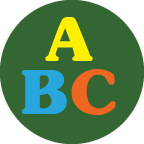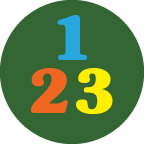Orange
Using a fruit to teach the color orange
Instructions

- While making this dessert, chat about the color of the fruit, where oranges come from (trees, warm climate, etc.) and other items that are orange colored (pumpkin, carrot, etc.)
- Cut the top 1/4 of an orange off to use as a top
- Let the child draw a face with a black magic marker on the orange. Chat about including eyes on the face for seeing (optional)
- Help child hollow out the inside with a spoon and fill with orange sherbet
- Place the top back on orange and place in a pan in the freezer or enjoy immediately
- Serve for a snack or dessert
- Watch this video to learn about the color orange
Simplify
Having a child use a spoon to scoop out the insides of the orange is a fun way to develop hand strength for writing. Adults can loosen the insides of the orange if the pulp becomes difficult to remove.
Extend
Have a child find all of the seeds (if not seedless) and count the number of seeds in the orange. Ask the child to choose an orange crayon and write the word "orange" by himself or with an adult's help.
QUESTIONS FOR CHILD
What are some names of foods that need to be peeled to eat?
What do you think you will dream about tonight?
Materials
- orange
- black marker (optional)
- spoon
- orange sherbet
- freezer
Curriculum Plan Resources
Skills Focus
- Shape - Rectangle
- Color - Orange
- Number - 1-4 Review
- Alphabet - O, U
- Senses - Sight
- Character Trait - Responsibility
- Target Words - Under, Up, Down, Tall
Monthly Proverb
Yiddish- If each person sweeps in front of his own door the whole street is clean
Did You Know?
"The brain builds itself in response to the child’s experiences. Brain circuits that the child uses in daily life are strengthened. Those that the child doesn’t use fade away. "
National Research Council From Neurons to Neighborhoods, 2000
Books to Read
"AlphaBugs: A Pop Up Alphabet Book"
by David Carter (Activity 1)
"Deep In The Swamp"
by Donna Bateman (Activity 22)
"Head to Toe"
by E. Carle (Activity 10)
"AlphaBugs: A Pop Up Alphabet Book". VIDEO
by David Carter (Activity 1)
"Head to Toe". VIDEO
by Eric Carle (Activity 10)
"Deep in The Swamp". VIDEO
by Donna Bateman (Activity 22)
Music Playlist
"When The Saints Go Marching In"
by Pete Fountain, Album: Do You Know What It Means to Miss New Orleans? (Jazz) (Activity 2)
"Go, Flush, Wash, Dry"
by Martin Kerr, Album: Favorite Songs from the Family Learning House (Children) (Activity 24)
"The Noble Duke of York"
by Susan McRae, Album: Barney’s Song Book - 16 Favourites for Kids (Children) (Activity 15)
"When The Saints Go Marching In" VIDEO
by Pete Fountain (Activity 2)
"The Noble Duke of York" VIDEO
by Barney's Magical Musical Adventure (Activity 15)
"Go, Flush, Wash, Dry" VIDEO
by Martin Kerr, Album: Favorite Songs from the Family Learning House (Children) (Activity 24)
Monthly Materials List
Click Here to view the list!
Fingerplay / Poems / Songs
Sing/Say The Alphabet
(Activity 26 Month 5)
ABCDEFG HIJKLMNOP QRSTUV WXYZ
Now I’ve said my ABC’s, Next time won't you sing with me.


